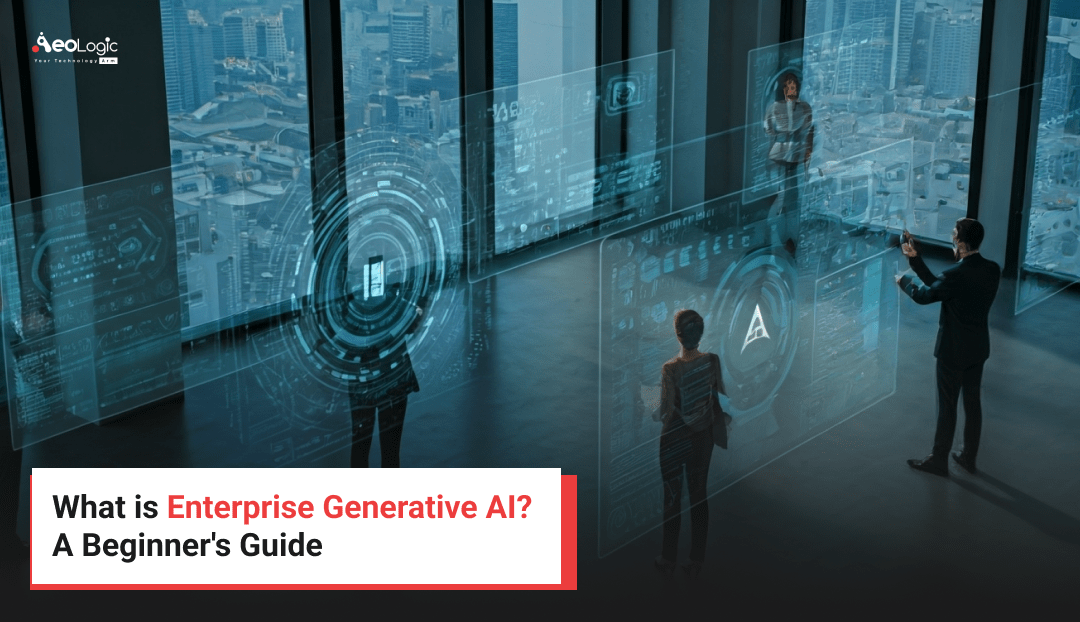Generative AI is now a key tool for many businesses. It helps change the way you work and think of new ideas. Unlike old types of AI, this new way can make new content such as text or pictures by learning from the data it has. There are many potential benefits for a company when you use generative ai. It can help make your work smoother, build new customer plans just for each person, and help you make better choices faster. Now, using generative ai as part of your strategy is not an option; it has to be done. You need to use it to keep your place in the market, because competition is strong and things are always changing.
Understanding Enterprise Generative AI

Enterprise generative AI is built to meet the special needs of large companies. It is not like the AI tools that people use for themselves. This type of generative ai helps businesses by working with big and organized sets of data. It goes well with the IT systems that the company has.
Many of these features come from using generative ai, large language models, and machine learning. They help you make good content quicker. They also help your team work better and solve important problems in the company. This kind of tool makes things easier for people who work in the office. It also helps give every customer a better experience. When you use generative ai, you can see it really helps the business and gets real results.
Defining Generative AI in the Business Context
Generative AI can make new content. It does this with smart programs and a lot of data. In the business world, generative ai helps companies meet their goals. This could be by making new marketing messages or by building new product images.
Generative ai models are very helpful for companies that want content to match their needs. They can write product descriptions for online stores. They can also look at user data and suggest services made for each person. By using artificial intelligence to figure out what people like in each case, it gives services that are just right for every company.
Generative ai is a transformative technology that does more than help companies create content. It changes how they use and handle information. With this, companies can make better plans and choose stronger actions. Generative ai works in many industries. When businesses use generative ai, they can figure out new ways to work better. It also lets them make decisions based on data.
How Enterprise Generative AI Differs from Consumer AI
Consumer AI and enterprise generative AI each have their own focus. You will find consumer AI in many things you use every day. For example, it can help you with personal assistant apps. It can also give you new streaming ideas. But, enterprise generative AI is made to help a business do bigger things. It can make customer service better or help the company follow rules about regulatory compliance.
There is a big difference between data privacy and security. A business has to work with a lot of private information. So, when a company uses generative AI, it has to make sure this AI follows all rules and laws about keeping data safe. It also should practice good data management, keep information private, and do the right thing. This is very important for keeping trust and for following regulatory compliance.
Enterprise generative AI is not like consumer AI. This is because it can connect to big systems and look into many work processes. It is made to meet special needs in a business. When you have a strong plan for AI, these tools help your business work better. They give real value by offering answers that your business can use. With generative ai, there is a way to get what you want out of the data and systems in your work.
Key Components of Enterprise Generative AI

You get the best results in enterprise generative ai when the base technology works well with good data systems. Things like machine learning and natural language tools help make smart outputs. At the same time, strong infrastructure, like linked data pipelines and systems that can grow, help it all work better.
Also, main AI models help people know what will happen next. This can be a good way to get good results in the end. A business with a strong start can use the full potential of generative ai. This will help people turn problems into strengths. So, you can get even more out of the potential of generative ai for business.
Foundational Models and Technologies
Enterprise generative AI helps businesses by using foundational models like large language models (LLMs). These large language models train with a lot of data. This helps them give good, creative answers. That is why generative ai and large language models are great for big business jobs.
Machine learning and deep learning help make generative ai models better. These tools check patterns in the data. With what they learn, generative models can give you new and helpful things for many needs. You can use them to make marketing work easier or to help people who work in creative industries.
There are new AI technologies that the business can use now. These help you work with many types of data. For example, AI can make written stories or show visual samples. This lets businesses keep up with market trends and changes.
Data Infrastructure Required for Implementation
A strong data setup is very important for generative ai to work well. You need good training data and large datasets. This helps make the training process easy and smooth.
Good data management matters if you want the AI model to give the right results. When you use clean input data, generative AI will make better content for you. Setting up the databases the right way lets you watch both old and new data. This helps people make good business choices, as they can see what is happening and what has changed.
Also, companies need fast systems to handle a lot of input data. These systems help run advanced generative models. The right tools can turn raw input data into useful knowledge. This is what makes generative ai projects work well.
Common Use Cases of Generative AI for Business

Generative AI has started to change how people in many fields do their work. Now, businesses use generative AI to help with content generation and to handle routine tasks faster and with less effort. With these generative AI capabilities, they get to be more productive and improve the way they work every day.
Some common use cases for generative ai include making marketing content feel more personal, giving better customer support with ai, and looking at data to guess trends before they happen. All these uses can help a business stay on top and be more competitive in the market. With generative ai tools, a company can improve the service it offers, finish routine tasks quicker, and boost customer satisfaction.
Streamlining Operations and Automation
Generative ai is used by many organizations to speed up work. It can handle jobs that usually take a lot of time and effort. Many businesses like to use generative ai because it helps them save money. There is less waste, and people can do more with their time when they have generative ai.
- Generative ai can take care of repetitive tasks, like making invoices. This gives employees more time to work on bigger projects.
- It can also sort and arrange data for people who own or manage a company. This helps work go better and easier.
- Using generative ai for planning looks ahead and helps things run better. It helps cut down on problems on the production line.
- AI tools find problems early, so businesses know what to fix before anything slows down.
This way of working helps a business stay ready to change and make their systems better. It can bring in new ideas at work and help people find good ways to do things.
Enhancing Customer Experience and Support
Generative AI is changing the way people talk to customer service. It helps people feel happier with the help they get. It does this by using natural language to boost customer support in many ways.
- AI-driven chatbots are always working. They can answer your questions fast and get the right answer most of the time.
- When customer feeling is studied, each person gets better help right away.
- Automated FAQs and the detailed knowledge base help everyone find what they need. It makes the experience better for all.
- AI gives teams good ideas. This lets support teams fix problems more quickly.
All of this shows that generative AI plays a big role now in customer service. It helps to make the service better for people. Generative AI can also make work easier for those who help customers. There is no doubt that this is the way forward for customer service.
Benefits and Challenges of Adopting Enterprise Generative AI
Using generative AI can help a business in many ways. It can make work go faster and help save money. A company can get an edge in the market with this tool. These machine-driven tools lower mistakes people make. They also help everyone get more done.
But when a company starts to use generative ai, it can run into some problems. These can be things like worrying about data privacy or dealing with other ethical issues. A company might also face discriminatory outcomes, which are not good for people. This is why companies need to have good plans. A good plan can help to handle any risks, keep data safe, and stop unfair results. If they do this, they can get the most out of generative ai and avoid big problems with data privacy or discriminatory outcomes.
Major Advantages for Enterprises
Using generative ai can give businesses a lot of good things.
- Boosted productivity: With generative ai, companies can use it to do repetitive tasks. This lets people stop worrying about the same jobs and put their time into new ideas that can help the business grow.
- Efficient cost-saving measures: When you let generative ai do the boring and repeated work, day-to-day costs go down.
- Sharper competitiveness: Using generative ai brings new ways to be creative. It also makes it much easier to create new marketing content that speaks to people you want to reach.
- Insightful market strategies: Prediction tools with generative ai help spot trends as they happen. These tools can give ideas about what the market will do next.
Bringing ai into your business can help you grow. You get real data and good advice that you can use. This makes it easier for your business to get better and move up.
Typical Risks and Pitfalls to Watch Out For
Generative AI can give you new ideas, but there be some risks that can come up.
- Data vulnerabilities: There is always a chance that someone can get in without permission when you work with sensitive data.
- Intellectual property disputes: Using results created by AI can sometimes break copyright laws.
- Bias in outcomes: Bad or unbalanced data can make the algorithm keep old ideas that are not fair.
- Compliance challenges: Dealing with rules and laws can slow business changes that need to happen quickly.
Being ready for risk helps you deal with problems. This makes the switch to using generative AI better.
A Beginner’s Guide to Getting Started with Generative AI in Your Enterprise
To use generative AI in the best way, you need to make good plans and give the right resources. When you pick a simple and clear way to do things, it helps your business solve common problems with less trouble. This also helps you get the most value from generative AI.
What You’ll Need Before You Begin (Skills, Tools, & Resources)
If you have strong skills in data analysis and machine learning, it can help you use generative ai much better. Working with large datasets is also key. You should know about natural language and things like natural language processing (NLP) and generative models. These tools are good for content creation and make the experience better for your customers.
It’s good to use strong AI tools and platforms. These will help your team train AI models the right way. At the same time, they help you follow data privacy rules. When you have these things in place, you can use the power of generative ai more easily. This helps you get the most out of new natural language and content creation tools.
Step-by-Step Guide to Implementing Enterprise Generative AI
A clear plan is important if you want to get the best results from using generative AI in your business. First, find out what your company needs. You should make your goals clear with this. This helps you improve customer experience and makes work easier. After that, choose the best generative AI tools for your use cases. Try to work with AI providers who know a lot about the things that matter most to your business.
Bringing the ai model into your current systems is important. You need to train it with large datasets. This step helps the system get better over time. You must also put data privacy and intellectual property rights first. This is key if you want to keep up as things change with AI. Both data privacy and intellectual property are very important for your business.
Step 1: Assess Business Needs and Set Clear Objectives
Identifying your business needs is the first and most important step to use generative ai. Look at how your business works and keep an eye on market trends. This can help you find good use cases that match your main goals. For example, your business might use generative ai for content creation or to improve customer service. To get the most from generative ai, set clear and measurable goals.
You need to pick an ai model that fits your needs. Always make sure it solves your main problems. Clear goals help when you use this technology. They also make it simpler to use resources better and handle risk management. When you follow these steps, your business will see more of the benefits of generative ai.
Step 2: Choose the Right Generative AI Tools and Partners
Choosing the best generative ai tools is important for your business. You have to know what your goals are and what each tool or model can do for you. Check out different choices, like large language models or other software, and see which one fits what you need. A good way to use generative ai can be for content creation or to help with customer support.
It is good to work with the right partners when you set up generative ai tools. This helps you do things in the best way. Be sure to think about data privacy and all rules for regulatory compliance. You need to use the right training data as well to get the best results. The generative ai tools you pick now will shape how well you and your team do in the future. Working with good partners and following best practices will make a big difference.
Step 3: Integrate and Train Your AI System
Bringing your AI system into use and training it needs good planning and the right steps. To start, you have to make sure you use high-quality input data. This means picking large datasets and using historical data that fit your use cases. It is also important to work with all stakeholders. Together, you can find out what customers need and set goals that you can measure.
If you use best practices in data management, you can lower the risk and help your generative ai model work better. This lets you get the full benefits of generative ai in many different industries. You can have a better customer experience and do good work across all of your areas. When you put the right info into your ai model and make a clear plan, you can see real results for your company. This is how you get the potential benefits from your generative ai.
Conclusion
To sum up, generative artificial intelligence is a new and powerful technology. It brings many benefits to lots of industries. When businesses use generative AI, they can make the customer experience better. It also helps to make work inside the company run more smoothly. It cuts down on repetitive tasks. Companies can also find new ways to do data analysis.
Taking advantage of the benefits of generative AI helps companies stay ahead in today’s fast-moving market. It is important for companies to know about regulatory compliance and intellectual property when they use generative artificial intelligence. These things matter a lot. They help businesses get the most out of this technology and grow well in the future.
Frequently Asked Questions
What industries benefit most from enterprise generative AI?
Enterprise generative AI is good for helping many types of businesses, like healthcare, finance, and retail. These areas use generative AI and data analysis to work with large amounts of information. They use it to give a more personal feel to what they offer customers. It can also help them do some work by itself, so people don’t have to do everything. This lets their teams work better and come up with new ideas or ways to get things done.
How can businesses ensure data privacy and security with generative AI?
To make sure data privacy and security are kept safe when using generative ai, businesses have to set up strong rules for how people use data. They should use encryption and set up secure ways to control who gets in. It is also good to do regular checks on their systems. People who work there should get training on the best practices for keeping data safe. Businesses need to follow all rules that are given to them and be open about their ways of using data.
What are some common mistakes when starting with enterprise generative AI?
Some common mistakes that people new to generative ai in the business world make are not knowing what the company really needs, ignoring if the data is good, leaving out the key people when starting, not thinking about the right and wrong sides, and not putting enough money or time into good training. If you do not make these mistakes, it can help the setup of generative ai go smoother. This way, you have a better shot at making it work well in your company.
How do you measure ROI for enterprise generative AI projects?
Measuring the return on investment (ROI) for enterprise generative ai projects means you need to look at cost savings, better efficiency, and more revenue. You also have to check how much productivity goes up, how much you save on work costs, and if customer satisfaction gets better. By keeping watch on these things all the time, you can make sure the project gives good results over time.







